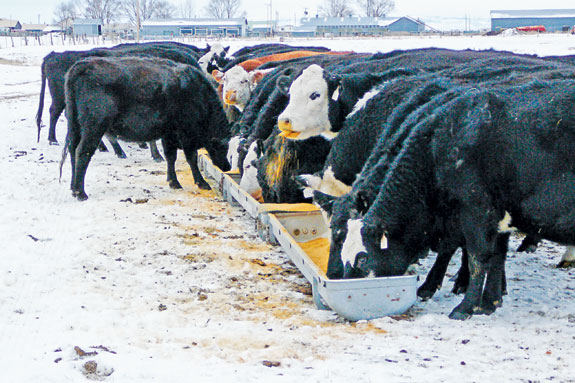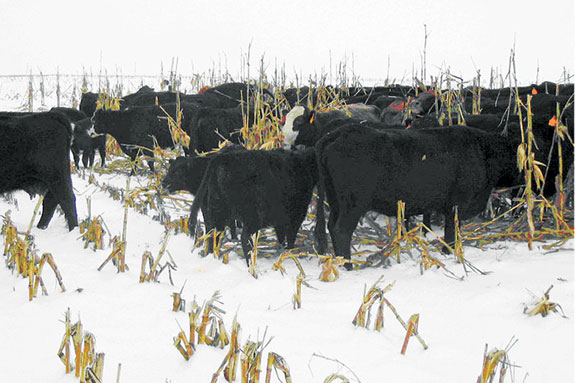Craig Iwanski, a veterinarian in north-central Kansas who also works with cattle nutrition, said it’s sometimes feasible to graze wheat or use triticale or turnips. “
Anything cows can harvest saves money. They’re the most efficient harvesters, if we can let them graze and not have to feed with a truck.”
Iwanski said poor-quality forages can be supplemented with a variety of protein sources. “In the Midwest some producers use wet distillers grains, which can be fed at 10 pounds a day to get the necessary pound of protein cattle need.”
Many people use liquid supplements, but he feels this is not cost-effective. “You may be paying $90 for a 200-pound tub that’s only 30 percent protein,” he said.
“That’s about $1.50 per pound of protein, whereas alfalfa hay may be about 55 to 60 cents per pound. Alfalfa, even when expensive, is still the best protein supplement because you also get vitamin A, energy and some roughage.”
“In our region, alternative sources of winter feed include corn stalks and milo (sorghum) stubble,” said Iwanski.
“We have access to wet distillers grains, which is a high-energy source and also provides fat and protein. People just need to be careful how much they feed.
If it’s more than 40 percent of the total dry matter in the ration, watch the sulfur content or you may run into problems.”
“Non-traditional forages coming into common use in the Northwest include teff and triticale,” said Bohnert. You can cut these for hay or graze them. Teff is a warm-season annual grass.
“Some of our common alternative feeds include grass seed straw, distillers grains and cornstalks,” he said.
“Some people bale cornstalks – to transport them – but there’s a lot of waste. Cull onions, turnips, potatoes, carrots, dry beans and other vegetables are available in some areas.
Vegetable waste from food processing can be useful, depending on where you are located and how you might feed it.”
Bakery waste can be added to cattle rations if you’re located near a bread-making factory or cookie/candy bar manufacturer.
“Food companies get rid of cull products occasionally and people have fed these. You must be careful how much you feed and balance the diet, but these can be utilized.
A nutritionist in Oregon once created a ration using cherry pies, candy bars and corn flakes as part of the energy base, and cattle did fine.”

Make sure it will work
The main thing that limits use of some feedstuffs is location. It costs too much to transport them, especially feedstuffs with high moisture content like wet distillers grains, cull potatoes or onions, unless they are nearby.
You’d be paying a lot for hauling water. If you are more than 50 miles away, this option isn’t economical.
Moisture content is a concern in cold weather. “A wet vegetable waste may become too frozen to handle – to transport or feed,” explained Bohnert.
“But if you can haul it all at once, it could make good silage. It might be worthwhile to purchase a bagger if you know you’ll have access to a certain product long-term.
Then you can mix it with low-quality grass hay or straw. Once it’s fermented, it can be fed year-round.”
Don’t assume a certain feed will work until you know the moisture and nutrient levels. “One producer wanted to feed onions and haul them from Ontario to Burns, and had a nutrient analysis conducted,” said Bohnert.
“But when we calculated how much dry matter he was getting per ton, we realized he could buy alfalfa hay cheaper, especially after figuring hauling costs.”
“With 10 tons of onions, you may only have 2 tons of dry matter. With alfalfa, you might have 8 tons of dry matter in a 10-ton load,” he said.
If cattle have some form of roughage as filler, alfalfa hay works well as a supplement to balance the ration. Compared with other supplement options, it may still pencil out because currently most of them are higher priced as well.
Test for toxins
“When using alternative feed, be aware of potential contaminants or toxins. With turnips or camelina meal (byproduct of oil extraction for biodiesel production), think about glucosinolates which can affect thyroid function,” said Bohnert.
“When using grass seed straw (aftermath from growing grass seed), fescue or perennial ryegrass may contain endophyte fungi, which produce toxins.
Problems can occur with plants that have ergot alkaloids.” These can hinder reproduction or interfere with blood circulation to the extremities – which may result in frozen ears, tails or feet.
Bohnert told of one producer who once lost 600 cows after feeding fescue grass seed straw and not having it tested. When weather got cold, cows froze their feet. He advises producers to check for potential toxins or mold.
“For example, corn can have deadly aflatoxins, and many feedstuffs can mold if wet. Distillers grains are a good source of energy and protein but can have high sulfur levels, which can cause ‘polio’ in cattle,” said Bohnert.

Storage and feeding issues
Storage is another issue with some feeds. How will you store a wet feed if it’s not delivered every day? Can it be stored in a grain bin or silo?
“Distillers grains contain fat and tend to bind and bridge in a grain bin, which means someone has to get in and knock it down, which can be dangerous,” said Bohnert.
“With turnips or cull potatoes, there’s risk for choke. You might drive over them with a tractor to break them up. Distillers grain is best fed in troughs; you lose too much if you feed on the ground.”
One producer used old belting to feed on. Bohnert said a procurer could put this along a fence so cattle only have access to one side (to minimize trampling).
“In the Southwest we fed cubes with a feeder on the back of a pickup or trailer as we drove along. A person could do this with distillers grains along the fence, on top of belting to keep it out of the dirt,” he said.
Feedbunks can be created using materials available. When a study on distillers grains as a feed source was conducted at Oregon State, the university got some old torpedo tubes the government was getting rid of. “These were aluminum, lightweight and made great feedbunks,” said Bohnert.
Iwanski said you can mix wet distillers grains with dry feed to give it some bulk to handle better with a feed truck or wagon. There are various formulations people have used with distillers grains, wet or dry.
“Some people use it as a meal or in pellets,” he said. “The wet form is easier to handle because the dry is light and fluffy, making it harder to feed by itself. It works better if you include it in a mixed ration, with a feed truck.”
Bohnert said the liquid (“syrup”) from distillers grains can be useful if you can figure out a way to feed it. One producer used old bathtubs. ![]()
How much to feed?
“Some alternative feeds can be fed in substantial amounts while others should be limited because of fat content or other factors. You don’t always know how much to feed,” said Oregon State extension agent David Bohnert.
With products that aren’t routinely fed, there’s not much data on nutrient content and no established criteria for how much to feed.
“By contrast, we have a good idea about nutrient content of corn, barley and soybean meal. Some regional foodstuffs may have different moisture content and growing conditions, and nutrient levels may be variable.
They need to be tested for nutrient content – then you can work them properly into a ration or have your extension agent or a nutritionist help you formulate an appropriate diet.”
Field peas
Another protein source is field peas. “It’s 25 percent protein but can also be part of the energy content,” said veterinarian Craig Iwanski. A study in North Dakota showed that for cows you don’t need to process the peas.
“You can feed them whole and cows do fine. You can crack them to mix with corn, but in those trials there wasn’t much difference in rate of gain or condition scores when leaving it whole – on the ground or in a bunk. Some people mix peas half and half with corn.
“In the Dakotas, many farmers use it as a cover crop, and then it can be harvested for cattle. Price-wise this was the cheapest source of protein I could find this year – about 36 cents per pound of protein,” he said.
Crop aftermath
Soybean stubble can be grazed, if supplemented with energy and protein – since soybean stalks are mainly indigestible roughage. “Cows will eat it but won’t get much nutrition unless there are some whole soybeans in with it,” explained Iwanski.
“In our area it’s harder to find crop aftermath grazing today with no-till practices. Many farmers don’t want cattle on fields because they’re worried about soil compaction. This could be an issue if you had 150 cows on a 50-acre field. But we have enough freeze-thaw cycles here to help reverse compaction,” he said.
PHOTOS
Top and Middle: Cattle are fed distillers grain from some inexpensive feedbunks created from old aluminum torpedo tubes sold by the government.
Bottom: Cattle graze on winter corn stalks. Photos courtesy of Dave Bohnert.







